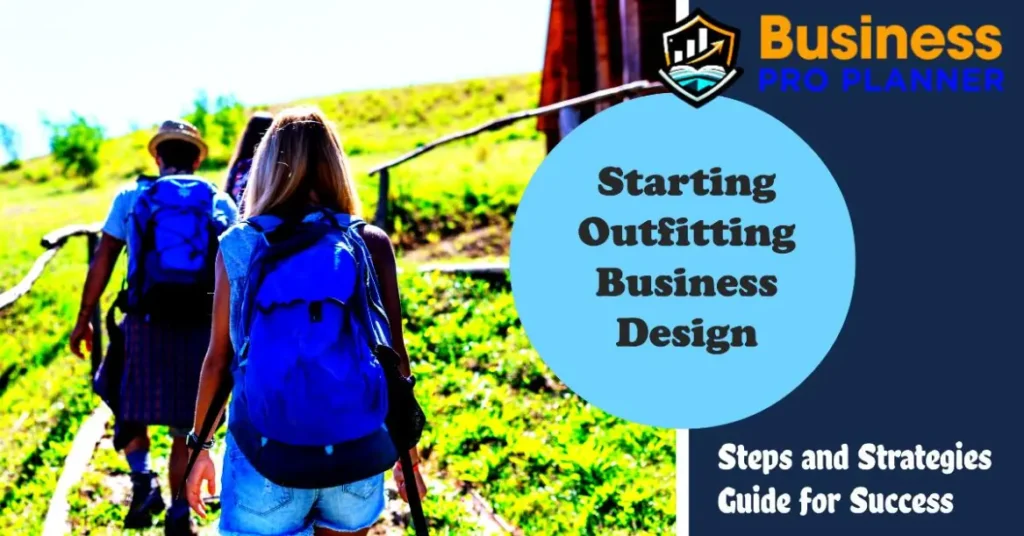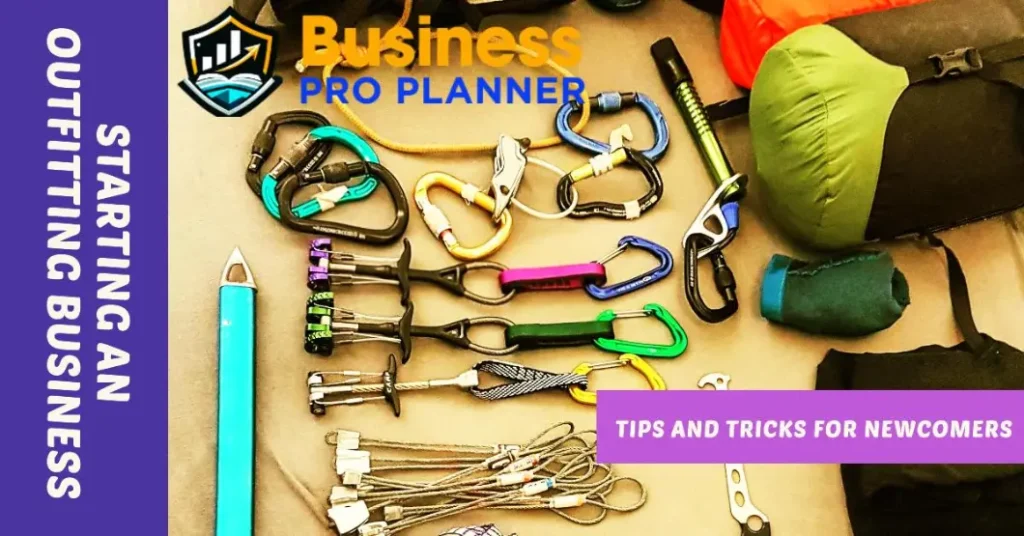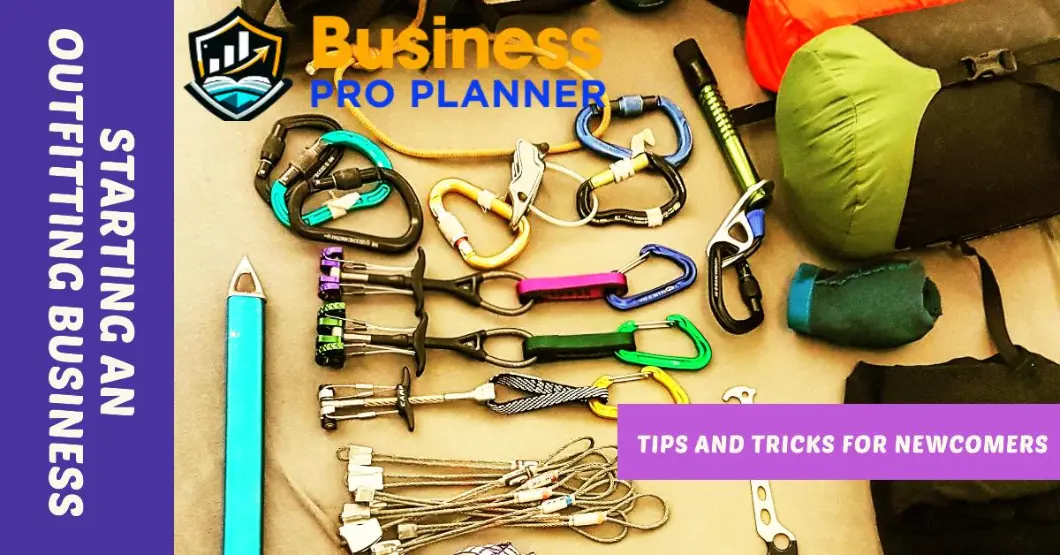Starting an outfitting business allows you to turn your passion for outdoor activities like hunting, fishing, and hiking into a thriving small business. Outfitters provide guided trips, gear, and expertise to clients seeking an immersive adventure in the great outdoors. It’s time to start an outfitting business.
Launching a successful outfitting company takes careful planning, substantial startup investment, and an entrepreneurial spirit, but the ability to make a living sharing your love of nature makes it rewarding.
With the right planning and preparation, you can start a successful outfitting business. Explore the essential steps for initiating an outfitting enterprise with our detailed guide.
Understand the Outfitting Industry

Outfitting Industry Overview – Size and Growth
Over the previous five years, the outfitting sector has demonstrated consistent expansion. Based on IBISWorld statistics, outfitters within the United States generate an estimated annual revenue of $4 billion as of 2022. The quantity of enterprises has risen at an average rate of 2.2% over the past five years, reaching approximately 4,500 active outfitters.
Demand is driven by rising disposable income, the growing popularity of outdoor recreational activities, and increased tourism activity. Industry research firm AnythingResearch predicts the outfitting industry will continue moderate expansion over the next five years. Favorable trends like higher consumer spending on experiences, growing interest in unique vacations, and revitalized travel demand should benefit outfitters.
However, the industry faces challenges like liability risks, licensing requirements, seasonal revenue variability, and reliance on favorable weather and environmental conditions. With proper planning, the industry’s projected growth presents an attractive opportunity.
Trends and Challenges
Some key trends that are shaping the outfitting industry include:
- Increasing demand for personalized, custom experiences like private family outings or trips tailored to specific ability levels. Outfitters need to provide customizable offerings.
- Growth in multi-activity packaged trips combining things like hunting, fishing, hiking, rafting, and horseback riding. Variety helps attract new clients.
- Rising interest in less common activities like kayaking, rock climbing, mountain biking, and backcountry skiing. Outfitters can specialize in unique niches.
- Vacationers seek more than just guided excursions – they want true adventures and challenging experiences. Outfitters need to prepare more intensive itineraries.
- Higher operating costs for things like insurance, fuel, vehicles, and equipment maintenance eat into profit margins. Efficiency and cost control are imperative.
Outfitters also face challenges like liability risks, difficulty finding experienced guides during labor shortages, seasonality in demand, uncertain environmental conditions, and growing licensing/permitting complexity. Overall, the trends point to opportunities for growth, but outfitters must adapt their offerings while controlling costs and risks.
Types of Outfitting Businesses
Some common types of outfitters include:
- Hunting Outfitters: Provide guided hunting trips, arranging transportation, licenses, gear, hunting dogs or horses, field dressing, and more.
- Fishing Outfitters: Offer guided fishing adventures, handling all equipment, boats, camp set-up, instruction, licensing, and preparation/transport of catches.
- Hiking Outfitters: Lead hiking, backpacking, and climbing excursions, arranging for trail permits, gear, meal planning, navigation, and naturalist instruction.
- Rafting Outfitters: Specialize in whitewater rafting trips, providing rafts, river gear, camp set-up, and guides.
- Snowmobiling Outfitters: Offer snowmobile tours, providing the vehicles, gear, trail passes, instruction, avalanche safety, and guides.
- Horseback Riding Outfitters: Provide guided horseback rides, arranging for the horses, gear, instruction, and trail access.
Benefits and Drawbacks Outfitting Business
Benefits:
Key benefits of an outfitting business include:
- Fulfilling work sharing your passion for the outdoors and introducing others to activities you love.
- Chance to make a good living monetizing your skills and knowledge of hunting, fishing, wilderness survival, etc.
- Opportunities to spend extensive time outdoors in adventuresome work environments.
- Flexible seasonal schedule during peak operating months, often with winters off.
- Ability to start your own small business with a modest initial investment.
- Providing a needed service to adventurers and contributing to local tourism economies.
- Building a lifestyle brand through a reputable outfitting company.
Drawbacks:
Potential drawbacks to weigh include:
- Substantial startup costs for gear, vehicles, licenses, insurance, etc. Outfitting is a capital-intensive business.
- Revenue fluctuations between peak and off-seasons. Cash flow planning is crucial.
- Dealing with challenging weather, hunt conditions, and potential hazards leading trips in the wilderness. Safety management is key.
- Physically demanding work guiding trips across difficult terrain and hazards.
- Managing extensive business operations like bookings, supplies, equipment maintenance, licensing, etc.
- Potential for substantial liability if clients are injured or dissatisfied with trips. Mitigating risks is imperative.
Overall, outfitting delivers immense fulfillment and income potential despite its challenges. With proper planning and risk management, the benefits far outweigh the drawbacks for most outfitters.
Startup Cost of Outfitting Business
Outfitting startups require considerable capital investment. Initial costs often total $50,000 to $100,000+ to secure equipment, vehicles, licenses, inventory, insurance, facilities, and operating funds. Key startup costs include:
- Gear like firearms, fishing equipment, apparel, tents, etc. at around $20,000
- Transport vehicles such as trucks, ATVs, snowmobiles, and trailers at roughly $30,000
- Office space, kennels, storage facilities – $8,000+
- Insurance policies covering liability, vehicles, workers’ comp – $10,000+ annually
- Licensing, permits, and applications fees – $2,000+
- Legal, accounting, and consulting fees – $5,000+
- Inventory, operating cash reserves – $10,000+
- Marketing materials, website – $5,000+
Outfitting entrepreneurs should ensure sufficient capital to cover all startup costs before launching. Grants, business loans, private investors, or business partners can help fund new outfitters.
Key Steps Involve in Start a Profitable Outfitting Business

Business Planning and Documentation
Careful planning is key to creating a sustainable outfitting business. Outline all the key details and logistics in a comprehensive business plan:
- Business description and objectives
- Services, trips, and activities offered
- Target customer segments
- Operational plan and supply needs
- Marketing and sales strategies
- Financial projections and investment requirements
- Licenses and permits needed
- Insurance requirements
- Location and Facilities
- Growth opportunities
You’ll also need to register your business and obtain all required documentation like business licenses and tax IDs.
A common choice for outfitting businesses is forming a Limited Liability Company (LLC), which provides liability protection for your assets. Consult with business attorneys and accountants to determine the right business structure for your specific outfitting operation.
Licenses and Permits
Outfitting businesses need a variety of licenses and permits, depending on your location and services:
- Business license: Register your outfitting business with the state and local municipality.
- Seller’s permit: Required to collect sales tax from outfitting customers in most states.
- Outfitters license: States require special outfitter licenses for fishing, hunting, rafting, or horseback guides.
- Land leases: Secure leases allowing access to private land for guided trips.
- Permits: Obtain permits for activities like hiking, camping, hunting, or fishing on public lands.
Research the specific licenses and permits required for the services you plan to offer in the states/areas where you will operate.
Insurance Needs
Insurance is vital to protect yourself from liability in an industry with inherent risks like outfitting. Common policies include:
- General liability insurance: Covers legal costs if customers are injured or their property is damaged.
- Commercial auto insurance: For company vehicles transporting and outfitting customers.
- Workers’ compensation: Provides coverage for injuries or illnesses of employees/guides.
- Umbrella insurance: Additional liability coverage on top of general and auto insurance policies.
Consult with insurance brokers who understand the needs of outfitters to ensure adequate, affordable coverage.
Gear and Equipment
The specific gear you need will vary based on your offered activities, but every outfitter requires:
- Transport vehicles like trucks, SUVs, vans, trailers, snowmobiles, boats, rafts, and off-road vehicles. Invest in vehicles suited for rugged terrain and wilderness areas.
- Camping and lodging gear – Tents, shelters, sleeping bags, cots, cooking equipment, food, first aid kits.
- Activity gear – Hunting/fishing tools and apparel, hiking/climbing gear, river equipment, horseback riding tack, snowmobiling gear, etc. Provide high-quality gear to ensure client safety and comfort.
- Safety and emergency equipment – Fire extinguishers, communications devices like satellite phones/radios, navigation tools, weapon and ammo storage, survival kits, trauma medical kits, flare guns, etc.
Facility Requirements
While outfitting trips involve spending extensive time in the wilderness, you will need some facilities to run your business:
- Office space for administrative work like booking trips and billing clients.
- Insured storage facilities for vehicles, camping gear, specialty equipment, weapons, ammo, etc.
- Kennels and stables provide hunting dogs or horses.
Look for properties near outdoor recreational areas optimal for the trips you want to offer.
Building Your Clientele
Marketing and networking are critical to building your client base:
- Create a professional website showcasing your services, location, experience, and past customer reviews/testimonials.
- List your outfitting business on online directories and marketplaces like Outfitters and Guides Directory, Discover Outdoors, and Off the Grid.
- Reach out to local hotels and tourism bureaus to be included in area recommendations for activities. Offer commissionable packages.
- Attend outdoor recreation trade shows and conventions to connect with potential clients.
- Establish relationships with regional hunting and fishing organizations as sources for bookings.
- Get to know other local guides and outfitters, and refer clients to each other when capacity-constrained.
- Promote your trips through marketing channels like social media, SEO, and email newsletters.
- Offer special deals, contests, and discounts to build initial interest. For example, 10% off for early bookings.
Staffing Your Outfitting Business
Experienced guides are vital to leading safe, rewarding expeditions. When hiring:
- Look for guides with substantial experience in your activity like hunting, rafting, horsemanship, etc.
- Ensure they have specialized certifications and licenses like Wilderness First Responder training, rafting licenses, etc.
- Hire guides who exemplify a service mindset and can create exceptional experiences.
- Provide regular guide training on safety protocols, customer service, trip procedures, emergency response, etc.
- Offer competitive pay and benefits to attract and retain top guiding talent.
Delivering 5-Star Service
Making clients feel welcome and appreciated goes a long way. Be sure to:
- Communicate proactively leading up to trips to handle planning details. Follow up post-trip.
- Keep groups small and personalized based on experience levels.
- Take time to get to know clients; build rapport.
- Occasionally capture photos/videos of clients in action to share later.
- Serve delicious, filling meals even when camping.
- Bring along welcome gifts like gear, local goods, or souvenirs.
- Collect client feedback through surveys, reviews, and testimonials to improve continually.
By emphasizing safety, service, and comfort, you can excel in this exciting industry as an outfitter!
Operations and Ongoing Business
With licenses, plans, and systems in place, you’re ready to begin outfitting operations. Focus on:
- Customer Service: Provide safe, organized, and enjoyable experiences through knowledgeable guides. Address any issues promptly.
- Safety Procedures: Train guides in first aid/CPR, and boating/river safety basics. Establish emergency protocols and conduct practice exercises.
- Business Administration: Handle reservations, payments, permits/tags, bookkeeping, taxes, and other back-office tasks regularly.
- Inventory Management: Track equipment condition, restock supplies, and order in advance of high seasons if needed.
- Marketing and Sales: Continue promoting via a variety of marketing channels year-round to maintain bookings.
- Expansion Opportunities: Consider adding new offerings, locations, or acquisitions if the market warrants future growth.
- Community Outreach: Partner with local organizations on conservation, and environmental projects for community involvement.

At End
With hard work, excellent customer service, and marketing discipline, a thriving outfitting business can provide meaningful income and lifestyle in a fulfilling industry. Just be prepared for long hours outdoors!

